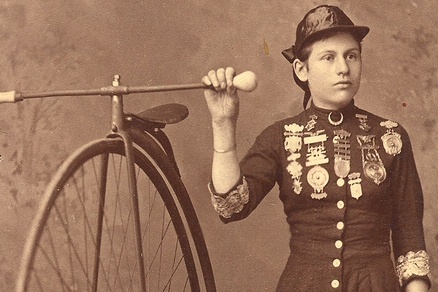The Women’s Tour de France begins on Sunday with a 124-kilometre time trial stage starting in Clermont-Ferrand. It is unlikely that cyclists will have a thought for Louise Armaindo when they set off on the roads… and that is a shame. Because this Quebecer was a bit like their ancestor.
Louise Armaindo, whose real name is Brisebois, is another of these “remarkable forgotten”, as Serge Bouchard liked to call them. Dead in anonymity, she had her hour of glory at the end of the 19th century, by multiplying the sports performances. First as a “strong woman”, then as a trapeze artist, as an endurance walker and finally as a cycling champion, the discipline that made her history.
“She was probably Canada’s first professional athlete and certainly one of the first champion cyclists in North America,” summarizes sports historian Ann Hall, author of the book Muscle on Wheels (2018, McGill-Queen’s University Press), dedicated to Louise Armaindo and her rivals of the time.
Ann Hall spent five good years trying to piece together the life of Louise Armaindo, combing through the sports pages of American newspapers of the time. His period of glory was abundantly chronicled, which allowed him to follow his career step by step. But she had much more difficulty in tracing the origins of this enigmatic character, who has always remained evasive about his past.
The historian is almost certain that Louise Brisebois – or Brisbois – was born in 1857 in Sainte-Anne-de-Bellevue, in the Montreal region. Other sources give birth to it in 1861, in Saint-Clet (Vaudreuil-Soulanges). This debate does not seem to have been settled. But what we do know is that Louise Armaindo was indeed French-Canadian, information that will subsequently be corroborated by several articles about her.
How did she one day end up in Chicago? It’s not clear. Perhaps by accompanying a traveling circus. Maybe because she had family there. Still, in the early 1880s, Louise Armaindo recorded her first exploits on a bicycle, or rather on a “big bi”, in the Windy City.
This ancestor of the bicycle, equipped with a large front wheel and a small rear wheel, was then a curiosity on both sides of the Atlantic. Track racing is held in the United States, usually as sporting challenges involving betting. It is entertainment for the time, just like the circus.
The machine is not easy to maneuver: the pedals and the steering are on the same wheel, there are no brakes and you fall from a height, the largest cycles rising up to 1.5 m from the ground!
But Louise Armaindo very quickly turns out to be one of the best of her cohort. It is measured equally against men and women in races sometimes taking place over 6 days, in 12-hour increments.
How to explain his successes? “I think she was tough [tough] and very determined. She had quite a character,” replies Ann Hall. Do not neglect either the contribution of a certain Tom Eck, who was his trainer, his agent and possibly his partner, “a character in himself”, adds the historian. Not to mention a possible consumption of cocaine and strychnine, stimulants in vogue at the time, which may have enhanced his performance.
But his glory will be short-lived. After a few years of domination, Louise Armaindo declines and accumulates setbacks. “The sport had grown, younger people appeared, there was more competition,” suggests Ann Hall. And she didn’t take care of herself. She had gained weight. »
Louise Armaindo’s last official race was in Chicago in 1893. When she left the circuit, the big bis were being replaced by the “safety bicycles”, ancestors of our current bicycles.
Louise migrates to Minneapolis, where she works as a waitress, then to Buffalo, where she shows off on a stationary bike in the window of a sporting goods store. Sad end after a brilliant career, but not yet the bottom of the barrel.
On November 2, 1896, during a fire, Louise Armaindo threw herself out of her hotel window to escape the flames. Her fall left her seriously injured and crippled, and she multiplied – in vain – the lawsuits against the establishment. She died four years later in Montreal and was buried in the Côte-des-Neiges cemetery in a common grave. We have since lost track of him.
One hundred and twenty-three years later, the name of Louise Armaindo comes out of oblivion. It is now quoted in works on the birth of women’s cycling and women’s sport in general. For Ann Hall, her story is also that of hundreds of women of her time, who chose spectator sport as a way to live freely and rise socially.
“They came from the working class. For them, it was a way out. It was better than working as servants or prostitutes. It was the entertainment that made this possible, ”concludes the historian.
In short, rebels, in their own way. And a golden film subject, somewhere between Louis Cyr and 2 seconds.
Is there a producer in the room?















